Types of Fish
What kind of Key West fish species are there? Here is a little list of the species of fish that are in the waters surrounding Key West. This is just a easy list of species broken down into categories for different types of environments depending on the time of year, you can be guided on to any of these species. The time of year is crucial for being able to effectively target certain types of fish, so definitely check in with your captain to see what’s been biting lately and he can tell you what is going to be most productive for you adventure!
See all the Florida Saltwater Fishing Regulations here.
Species List
Snapper
Mangrove Snapper
 Mangrove snappers (other names: gray snapper, mangos, grovers) are probably one of the most prevalent Key West fish species in the backcountry waters. They do in fact live up in the mangroves, as well as grass ledges, channels, and around structure in the shallows. Mangrove snappers are a very intense eaters, as they often times scare people when they are starting to get a bite. Mangrove snappers like to sniff out their prey for a certain amount of time (depending on how hungry they are) and then they attack. A lot of time my anglers are using small, live pinfish or pieces of cut bait to fish for mangrove snappers. Mangroves like to take the bait and run with it, sometimes without actually getting the hook, so letting them fully munch on your bait is the best way to keep one on. Mangrove snappers have to be 10″ to keep, and anglers are allowed 5 per person. These snappers are also found in deeper waters, but usually aren’t common in over 120ft. The best time to catch mangrove snappers is late July and August, when they are spawning. They are still caught year round, regardless of their spawn.
Mangrove snappers (other names: gray snapper, mangos, grovers) are probably one of the most prevalent Key West fish species in the backcountry waters. They do in fact live up in the mangroves, as well as grass ledges, channels, and around structure in the shallows. Mangrove snappers are a very intense eaters, as they often times scare people when they are starting to get a bite. Mangrove snappers like to sniff out their prey for a certain amount of time (depending on how hungry they are) and then they attack. A lot of time my anglers are using small, live pinfish or pieces of cut bait to fish for mangrove snappers. Mangroves like to take the bait and run with it, sometimes without actually getting the hook, so letting them fully munch on your bait is the best way to keep one on. Mangrove snappers have to be 10″ to keep, and anglers are allowed 5 per person. These snappers are also found in deeper waters, but usually aren’t common in over 120ft. The best time to catch mangrove snappers is late July and August, when they are spawning. They are still caught year round, regardless of their spawn.
Mutton Snapper
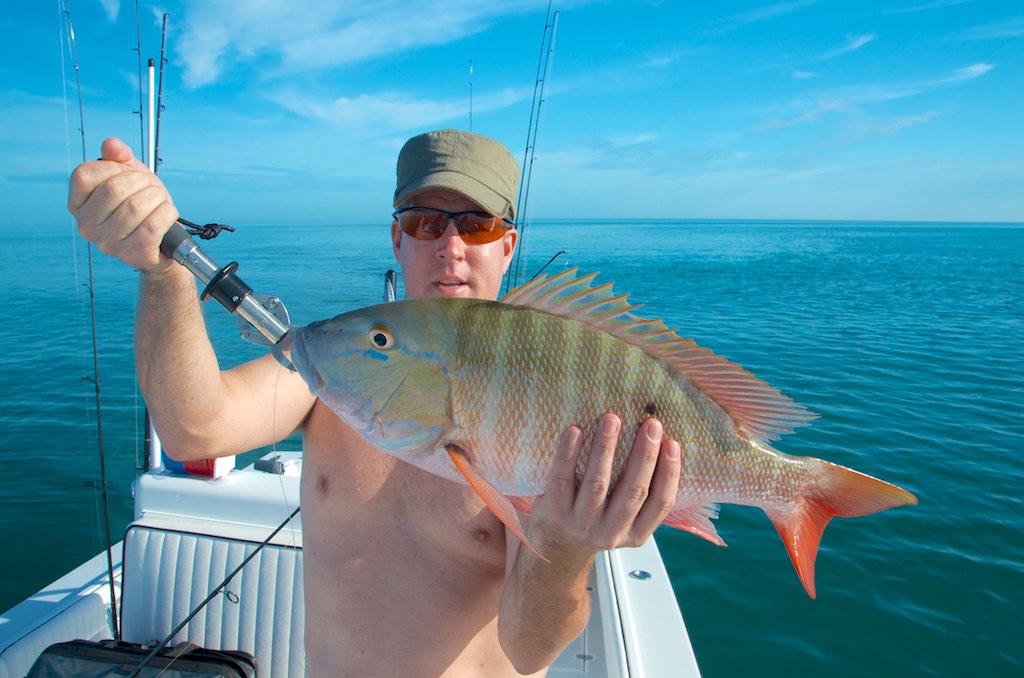 Mutton snappers are one of the more powerful snappers that we catch fishing Key West. Mutton snappers are known for their hard pull, and of course, their amazing dinner table presentation. Muttons are found in mostly deeper depths, like out at the reef, but they are caught in the backcountry and nearshore waters from time to time. They can be found in up to 280ft. Mutton snappers like to live in many different environments, including wrecks, hard sand bottom, and in coral. They eat a range of live bait, artificial jigs, crabs, and squid. Muttons are caught in all times of the year, but are most popular in their spawn in the months of May and June. The “mutton spawn” is a favorite among many offshore and reef charter boats, as they are piled up thick on the reefs. Mutton snapper have to be 16″ to keep, and anglers can keep 10 per person per day.
Mutton snappers are one of the more powerful snappers that we catch fishing Key West. Mutton snappers are known for their hard pull, and of course, their amazing dinner table presentation. Muttons are found in mostly deeper depths, like out at the reef, but they are caught in the backcountry and nearshore waters from time to time. They can be found in up to 280ft. Mutton snappers like to live in many different environments, including wrecks, hard sand bottom, and in coral. They eat a range of live bait, artificial jigs, crabs, and squid. Muttons are caught in all times of the year, but are most popular in their spawn in the months of May and June. The “mutton spawn” is a favorite among many offshore and reef charter boats, as they are piled up thick on the reefs. Mutton snapper have to be 16″ to keep, and anglers can keep 10 per person per day.
Yellowtail Snapper
 Yellowtail snapper are a favorite among the food fish you can catch off Key West. They are the most readily available reef fish that you can get into. Yellowtails live in depths from 20-220 feet. They are usually caught by anchoring up and chumming them out of their reef environment. Yellowtail snappers will often times come up to the back of the boat and turn the water yellow, because there are so many of them. They travel in large schools, and usually once you’re in them you can bet on getting close to your limit. Yellowtail snappers have to be 12 inches to keep, and you can keep up to 10 per angler. Yellowtail snappers are definitely a fish to go after if you are looking for some non stop action at the reef. They are fished for with small pieces of bait on small hooks.
Yellowtail snapper are a favorite among the food fish you can catch off Key West. They are the most readily available reef fish that you can get into. Yellowtails live in depths from 20-220 feet. They are usually caught by anchoring up and chumming them out of their reef environment. Yellowtail snappers will often times come up to the back of the boat and turn the water yellow, because there are so many of them. They travel in large schools, and usually once you’re in them you can bet on getting close to your limit. Yellowtail snappers have to be 12 inches to keep, and you can keep up to 10 per angler. Yellowtail snappers are definitely a fish to go after if you are looking for some non stop action at the reef. They are fished for with small pieces of bait on small hooks.
Lane Snapper
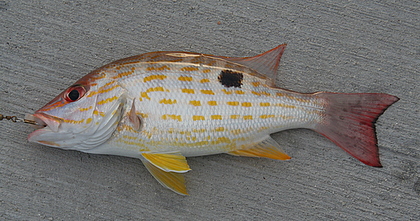 Lane snapper are probably one of the smaller types of snapper we get in to. Lanes are more of a shallow water snapper, which we catch in depths anywhere from 5 to 60ft. Lane snappers are a hard fighting and aggressive snapper, and typically are under 3 pounds. They are a good eating fish, and usually pretty easy to catch. They eat a big assortment of baits, but usually shrimp or pinfish work best. They are found in both Gulf and Atlantic waters. Lane snappers are always good to add to the bag for dinner, because they are readily available. Lane snappers only have to be 8″ to keep, so getting into keeper fish isn’t too hard at all. You usually want to bring in ones that are at least 12″ though, so you make the most out of the meat. 8″ snappers don’t have the most amount of meat on them, so we try and catch bigger ones so there are more smaller ones to grow up and reproduce. Anglers can keep 10 per person per day.
Lane snapper are probably one of the smaller types of snapper we get in to. Lanes are more of a shallow water snapper, which we catch in depths anywhere from 5 to 60ft. Lane snappers are a hard fighting and aggressive snapper, and typically are under 3 pounds. They are a good eating fish, and usually pretty easy to catch. They eat a big assortment of baits, but usually shrimp or pinfish work best. They are found in both Gulf and Atlantic waters. Lane snappers are always good to add to the bag for dinner, because they are readily available. Lane snappers only have to be 8″ to keep, so getting into keeper fish isn’t too hard at all. You usually want to bring in ones that are at least 12″ though, so you make the most out of the meat. 8″ snappers don’t have the most amount of meat on them, so we try and catch bigger ones so there are more smaller ones to grow up and reproduce. Anglers can keep 10 per person per day.
Tarpon

Tarpon boat-side after a long battle!
Atlantic Tarpon are among the favorite species of those who come fishing in the Key West backcountry. Tarpon are one of the hardest fighting, mean fish on the water. They range in size anywhere from 5 to 200 pounds, and can be caught on artificial, fly, dead and live bait. Tarpon are a local fish to Key West, as you may see under and around some of the docks at the marinas. They hang out in the marinas because people are always feeding them, as it is also a good place for protection. Some of these tarpon never leave these marinas once they enter them, because life there is just too easy. Many people ask if they can fish for the tarpon in the marinas, which is not only prohibited, but a very bad idea. If you were to throw just about anything in the water that resembles a fish or a piece of bait, you’ve got a pretty good chance that the tarpon are going to eat what you’re offering. Once the tarpon eats, it doesn’t know what to do because it is so used to its easy life of free meals. The tarpon will then freak out, and try to wrap your line around a piling or a dock (which usually have electrical cables and fuel hoses attached). The tarpon also might jump, which means they can land over or on a dock or boat, hurting those around as well as the tarpon. They will do anything to get that hook and line out of their face. So, please, don’t try hooking one of the pet tarpon in the marinas! Now, remember that jumping and fighting part I was talking about? They do this in their natural environment out in the backcountry and in Key West harbor. Tarpon migrate through the Keys in the spring, usually the most in April-June. Some tarpon are also here year round, but usually aren’t easy to target (they come up in random spots). Tarpon are the most popular type of fish to go for in the spring time, as most anglers request tarpon fishing months in advance. 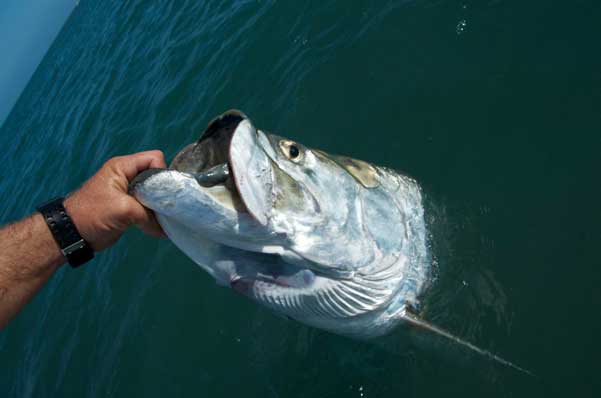 Tarpon are fished for with a number of baits, depending on what type of boat you are on. The flats boats and bay boats typically use artificial, fly, or live baits while the bigger and less maneuverable boats use cut bait to chum them. Either way you fish for them, they put up a very powerful long lasting fight. They almost always jump, trying to throw your hook out of their mouth and even breaking you off. Tarpon can get second and third winds when fighting them, so it’s best to try and land the fish as soon as possible. Tarpon are not to be brought in the boat, as it is against the state regulations. They have to be kept boat side, unless they are under 40 inches. Tarpon are not allowed to be harvested unless you buy a $50 kill tag, which can only be used for IGFA World Records. Tarpon are usually found in depths from 2-40 feet of water.
Tarpon are fished for with a number of baits, depending on what type of boat you are on. The flats boats and bay boats typically use artificial, fly, or live baits while the bigger and less maneuverable boats use cut bait to chum them. Either way you fish for them, they put up a very powerful long lasting fight. They almost always jump, trying to throw your hook out of their mouth and even breaking you off. Tarpon can get second and third winds when fighting them, so it’s best to try and land the fish as soon as possible. Tarpon are not to be brought in the boat, as it is against the state regulations. They have to be kept boat side, unless they are under 40 inches. Tarpon are not allowed to be harvested unless you buy a $50 kill tag, which can only be used for IGFA World Records. Tarpon are usually found in depths from 2-40 feet of water.
Grouper
Red Grouper
 Red groupers are caught almost year round in many different depths of water. They are caught in some channels in the backcountry, sometimes by accident while we are fishing for tarpon or jacks. Red groupers live in all types of environments as well, from grass bottom, coral, hard bottom, sand, reefs and wrecks. Red groupers are commonly caught while fishing the reefs, or jigging off the bottom. They range in sizes from 10-30 inches, and eat almost all kinds of bait. They are mainly caught on live pinfish or cut thread fins. Red grouper are an awesome fish to bring back for dinner, and usually have a good amount of meat on them. When grouper season is open, you can keep 3 red groupers per person, and the minimum size limit is 20″. *Grouper season is usually closed from the months of Jan-April.
Red groupers are caught almost year round in many different depths of water. They are caught in some channels in the backcountry, sometimes by accident while we are fishing for tarpon or jacks. Red groupers live in all types of environments as well, from grass bottom, coral, hard bottom, sand, reefs and wrecks. Red groupers are commonly caught while fishing the reefs, or jigging off the bottom. They range in sizes from 10-30 inches, and eat almost all kinds of bait. They are mainly caught on live pinfish or cut thread fins. Red grouper are an awesome fish to bring back for dinner, and usually have a good amount of meat on them. When grouper season is open, you can keep 3 red groupers per person, and the minimum size limit is 20″. *Grouper season is usually closed from the months of Jan-April.
Black grouper
 Black groupers, like red groupers, like to live in a lot of different environments as well. They are usually a little smarter than red grouper. They live primarily near structure where they can protect themselves, and will take your bait and hook right back into their holes, trying to break you off. Black groupers are usually found in a little more deeper depths than reds, and take a little more angling skills to get them to the boat. They range in a little bit bigger size than red grouper. Black grouper have to be 24″ to keep, and you can only keep 1 per angler. Black grouper give the best fight out of edible groupers. They take your bait very powerfully, and rip off line no matter what size reel you are using. Sometimes they will eat other smaller fish you have on your line.
Black groupers, like red groupers, like to live in a lot of different environments as well. They are usually a little smarter than red grouper. They live primarily near structure where they can protect themselves, and will take your bait and hook right back into their holes, trying to break you off. Black groupers are usually found in a little more deeper depths than reds, and take a little more angling skills to get them to the boat. They range in a little bit bigger size than red grouper. Black grouper have to be 24″ to keep, and you can only keep 1 per angler. Black grouper give the best fight out of edible groupers. They take your bait very powerfully, and rip off line no matter what size reel you are using. Sometimes they will eat other smaller fish you have on your line.
Goliath Grouper
 Goliath groupers, the biggest type of grouper, are the most powerful fish that we get into. They often break us off, since they are unexpected. They like to live on big bottom structures, like decent sized wrecks and coral heads. Goliath groupers eat just about everything, and have been known to even at small sharks. They like to steal fish from you that you are already currently reeling in, even other groupers. Goliath groupers are not allowed to be pulled out of the water, and are not allowed to be harvested. They are strictly a hard fighting sport fish. Goliath groupers eat just about anything that’s put in front of them. The best way to fish for them is to drop down a big bait, like a blue runner or a jack, and let it sit on the bottom where you know a goliath grouper is lurking. All of a sudden, your line will bounce, and the rod will slowly bend over. At this point, you have to really work hard to reel him away from the structure he’s trying to get into, or else it will snap you off. Goliath groupers are not a fish that are easy to get in, at least the bigger ones. Sometimes we catch some smaller ones in the mangroves, and even those fight good, but are way easier to get to the boat.
Goliath groupers, the biggest type of grouper, are the most powerful fish that we get into. They often break us off, since they are unexpected. They like to live on big bottom structures, like decent sized wrecks and coral heads. Goliath groupers eat just about everything, and have been known to even at small sharks. They like to steal fish from you that you are already currently reeling in, even other groupers. Goliath groupers are not allowed to be pulled out of the water, and are not allowed to be harvested. They are strictly a hard fighting sport fish. Goliath groupers eat just about anything that’s put in front of them. The best way to fish for them is to drop down a big bait, like a blue runner or a jack, and let it sit on the bottom where you know a goliath grouper is lurking. All of a sudden, your line will bounce, and the rod will slowly bend over. At this point, you have to really work hard to reel him away from the structure he’s trying to get into, or else it will snap you off. Goliath groupers are not a fish that are easy to get in, at least the bigger ones. Sometimes we catch some smaller ones in the mangroves, and even those fight good, but are way easier to get to the boat.
Sharks
Lemon Sharks
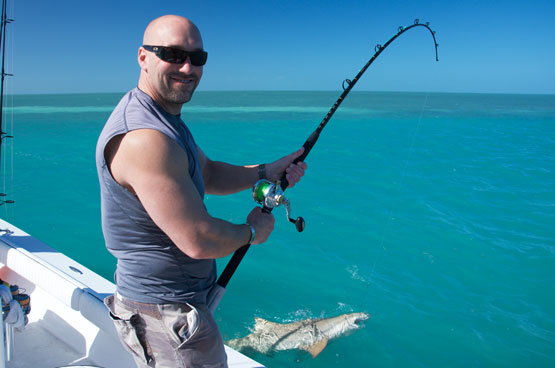
Lemon shark boatside.
Lemon sharks are probably the most popular type of shark that we get into in the backcountry. They are mean, powerful, aggressive, and usually come in packs of more than two sharks. Lemon sharks are not afraid to come right up to the boat to take a bait or a fish from you. They are often seen following a fish in that you already have on the line. Lemon sharks like shallow, grassy areas with a lot of flow. They can also be found just outside the backcountry around some hard bottom and wrecks in depths up to 50 feet. Younger lemon sharks hang out in the “nursery,” which is usually a shallow area around a mangrove island where it is easy for them to grow up. Once they mature, they will branch off into the shallow channels and flats that we often see them in. The average size for lemon sharks that we get into is 5-6 feet in length, but there are some that have been recorded up to 12 feet. As for most sharks, we keep them boat side and in the water where they cannot bite us. Lemon sharks are a type of aggressive shark that are not easy to handle after they reach a certain size. Lemon sharks are usually a golden/brown color with two sets of dorsal fins. The secondary dorsal fin is almost as large as the first one, which is an easy way to point one out. The runs a lemon shark makes while on the line is short spurts of energy and hard runs, followed by big head shakes, and more runs, until they get worn out.
Black Tip Sharks
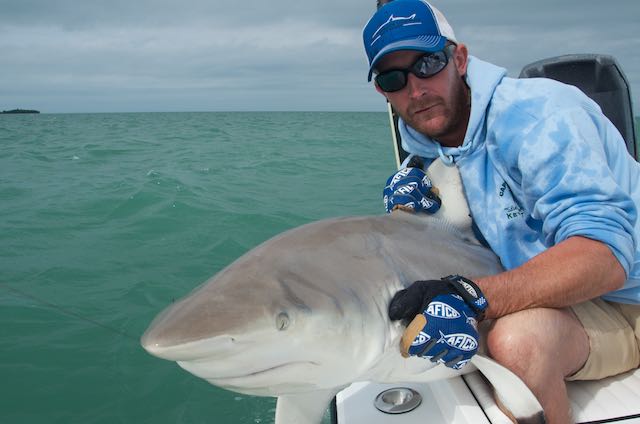 Black tips are typically a shark that is more by itself. They patrol tidal channels as well as shallow flats. Black tips often rip up into the shallows chasing barracudas and other shallow dwelling species. The fight of a black tip is usually a very straight and narrow, hard run. Black tips change direction a lot, and use their pointy shaped head to zip through the water at a fast speed. You’ll usually be able to tell when you have a black tip shark on the end of your line because they will run in a straight line, usually with the tide, sometimes making you follow them so you don’t get spooled! Black tips also live in shallow nurseries when they are younger, and move out into deeper backcountry areas when they mature. Black tips don’t get as large as some of the other shark species, but sure make up for it in their hard fight. Most of the black tips that we encounter fishing Key West are anywhere from 3 to 5 feet. Their body shape is very stout and muscular, made for speed.
Black tips are typically a shark that is more by itself. They patrol tidal channels as well as shallow flats. Black tips often rip up into the shallows chasing barracudas and other shallow dwelling species. The fight of a black tip is usually a very straight and narrow, hard run. Black tips change direction a lot, and use their pointy shaped head to zip through the water at a fast speed. You’ll usually be able to tell when you have a black tip shark on the end of your line because they will run in a straight line, usually with the tide, sometimes making you follow them so you don’t get spooled! Black tips also live in shallow nurseries when they are younger, and move out into deeper backcountry areas when they mature. Black tips don’t get as large as some of the other shark species, but sure make up for it in their hard fight. Most of the black tips that we encounter fishing Key West are anywhere from 3 to 5 feet. Their body shape is very stout and muscular, made for speed.
Bonnet Head Shark
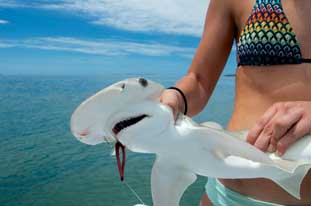 Bonnet head sharks, named for their “bonnet” shaped head, are found mainly on shallow flats. We see a lot of bonnet head sharks when we are sight fishing up on the flats for permit, bonefish, and barracudas. Bonnet heads make for a great fight, and are a nice surprise when sight fishing for other target species is slow. Bonnet heads feed primarily on crustaceans, shrimp, and crabs. They will usually not be seen in depths more than 15 feet. Most of the time when you catch a bonnet head shark, you’ll see them swim around the boat first. The easiest way to hook into one is to throw a buck tail jig in front of them that is tipped with a piece of shrimp. They can almost never turn this type of presentation down, as it smells to good. Bonnet head sharks don’t get much larger than 3 feet, and can be caught on light tackle rods without steel leader. Their mouths are positioned on the bottom of their face, just like hammer heads. Many people see these sharks and confuse them with their larger hammer head cousin.
Bonnet head sharks, named for their “bonnet” shaped head, are found mainly on shallow flats. We see a lot of bonnet head sharks when we are sight fishing up on the flats for permit, bonefish, and barracudas. Bonnet heads make for a great fight, and are a nice surprise when sight fishing for other target species is slow. Bonnet heads feed primarily on crustaceans, shrimp, and crabs. They will usually not be seen in depths more than 15 feet. Most of the time when you catch a bonnet head shark, you’ll see them swim around the boat first. The easiest way to hook into one is to throw a buck tail jig in front of them that is tipped with a piece of shrimp. They can almost never turn this type of presentation down, as it smells to good. Bonnet head sharks don’t get much larger than 3 feet, and can be caught on light tackle rods without steel leader. Their mouths are positioned on the bottom of their face, just like hammer heads. Many people see these sharks and confuse them with their larger hammer head cousin.
Nurse Sharks
 Nurse sharks are not the most aggressive shark that we see out on the waters of Key West, but they sure are just about everywhere. Nurse sharks are a bottom dwelling species that live in the shallows of the backcountry, as well as out on the reefs and wrecks. Nurse sharks are a slow moving shark, that is a definite opportunist. They have little feelers on the tops of their mouths like catfish do, and can always sense a dead fish. Nurse sharks sometimes live in the marinas where the tarpon are at, as they clean up the scraps from the filet tables that the tarpon aren’t designed to swallow. Nurse sharks don’t have the average set of teeth like some of the more standard looking sharks. Their teeth are almost in a circular type of inset half way inside their mouths. They have a suction ability, for pulling lobsters out of holes and grabbing on to crabs on the bottom. Sometimes nurse sharks lay on the bottom, as if they are sleeping. It is said that nurse sharks will lay on the bottom really still, and leave their mouths open. This way, critters will feel like they are going inside a safe little hole. When the prey is inside their mouth the nurse shark can then inhale the organisms and get an easy meal. This is just one way these sharks feed. Nurse sharks are,on average 5-7 feet.
Nurse sharks are not the most aggressive shark that we see out on the waters of Key West, but they sure are just about everywhere. Nurse sharks are a bottom dwelling species that live in the shallows of the backcountry, as well as out on the reefs and wrecks. Nurse sharks are a slow moving shark, that is a definite opportunist. They have little feelers on the tops of their mouths like catfish do, and can always sense a dead fish. Nurse sharks sometimes live in the marinas where the tarpon are at, as they clean up the scraps from the filet tables that the tarpon aren’t designed to swallow. Nurse sharks don’t have the average set of teeth like some of the more standard looking sharks. Their teeth are almost in a circular type of inset half way inside their mouths. They have a suction ability, for pulling lobsters out of holes and grabbing on to crabs on the bottom. Sometimes nurse sharks lay on the bottom, as if they are sleeping. It is said that nurse sharks will lay on the bottom really still, and leave their mouths open. This way, critters will feel like they are going inside a safe little hole. When the prey is inside their mouth the nurse shark can then inhale the organisms and get an easy meal. This is just one way these sharks feed. Nurse sharks are,on average 5-7 feet.
Bull Sharks
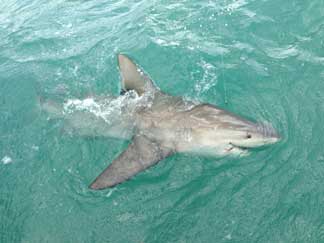 Bull sharks are definitely one of the most talked about shark. They have been known to attack people in many coastal areas. Bull sharks have the ability to also swim into fresh water, and still thrive. The term “bull” probably comes from bull sharks’ stocky shape, aggressive and unpredictable behavior, and their flat snouts. Bull sharks feed on all sorts of fish, but are a lot of times seen in areas where there are a lot of tarpon and big jacks around. Bull sharks have came up and bit tarpon to shreds while we were fighting one to the boat. This is more common at night, or in deeper channels where they are commonly seen throughout the year. Bull sharks are typically 5-7 feet. They are not a shark we get into every day, but are more common on the Gulf of Mexico side of the Key West backcountry. Bull sharks give an a very hard run, with lots of changing directions. They like to be on the bottom, so getting one up to the boat can sometimes be tough from their stocky and heavy profile. Bull sharks are similar in look to some lemon sharks, but are a little darker and have a lot more girth to them.
Bull sharks are definitely one of the most talked about shark. They have been known to attack people in many coastal areas. Bull sharks have the ability to also swim into fresh water, and still thrive. The term “bull” probably comes from bull sharks’ stocky shape, aggressive and unpredictable behavior, and their flat snouts. Bull sharks feed on all sorts of fish, but are a lot of times seen in areas where there are a lot of tarpon and big jacks around. Bull sharks have came up and bit tarpon to shreds while we were fighting one to the boat. This is more common at night, or in deeper channels where they are commonly seen throughout the year. Bull sharks are typically 5-7 feet. They are not a shark we get into every day, but are more common on the Gulf of Mexico side of the Key West backcountry. Bull sharks give an a very hard run, with lots of changing directions. They like to be on the bottom, so getting one up to the boat can sometimes be tough from their stocky and heavy profile. Bull sharks are similar in look to some lemon sharks, but are a little darker and have a lot more girth to them.
Sawtooth Sharks
 Sawtooth sharks, or saw fish, are a rare species to catch in Key West. We see them from time to time in the backcountry, but are not usually expected. Sawfish are found more up the coast by the Everglades National Park and Naples, FL. Sawfish have a very distinct snouts that look like chain saw blades. These are for getting fish that are hiding in the mud. Sawfish move that bill back and forth, even when you have them boat side. It is important to be really careful when landing a sawfish because they can swipe the boat and even yourself. Just like sting rays, the sawfish has a mouth and nostrils on the under side of it’s body. A lot of times when a saw fish gets on your line, you think it may be a big sting ray. Catching a saw fish is a very hard task, especially with the big ones. They try and mud themselves on the sea floor, and then all of a sudden run like crazy. Their flat, slender bodies help them move through the water like a giant carpet. Sawfish range anywhere from 4 to 16 feet, and are usually caught in channels in the backcountry. Sawfish are endangered as well, but seem to be making a bigger appearance in South Florida in the last few years.
Sawtooth sharks, or saw fish, are a rare species to catch in Key West. We see them from time to time in the backcountry, but are not usually expected. Sawfish are found more up the coast by the Everglades National Park and Naples, FL. Sawfish have a very distinct snouts that look like chain saw blades. These are for getting fish that are hiding in the mud. Sawfish move that bill back and forth, even when you have them boat side. It is important to be really careful when landing a sawfish because they can swipe the boat and even yourself. Just like sting rays, the sawfish has a mouth and nostrils on the under side of it’s body. A lot of times when a saw fish gets on your line, you think it may be a big sting ray. Catching a saw fish is a very hard task, especially with the big ones. They try and mud themselves on the sea floor, and then all of a sudden run like crazy. Their flat, slender bodies help them move through the water like a giant carpet. Sawfish range anywhere from 4 to 16 feet, and are usually caught in channels in the backcountry. Sawfish are endangered as well, but seem to be making a bigger appearance in South Florida in the last few years.
*Out of all of the sharks we catch, we always release them. Some sharks are okay to keep, but is sometimes frowned upon at the dock. Sharks are a pain to clean, and aren’t really that good eating. Catching these monsters and releasing them seems to be the best, and safest, practice of angling.
Permit
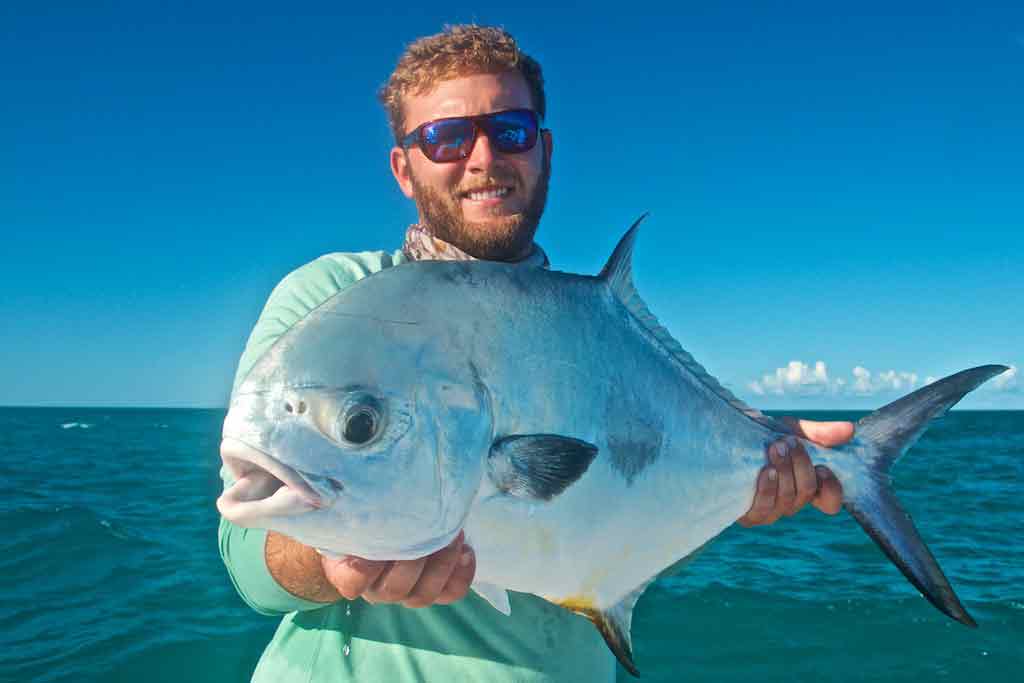 The permit (not the type you need when building a house) is one of the most illusive and hard to catch species in the backcountry. Permit are in the jack family, but are not as easy to catch as the rest of their cousins. Permit have a very good sense of smell, amazing eyesight, and loud noises can spook them. They feed on shrimp and crabs, and possibly some small bait fish. Permit have no teeth, just gummy lips. They have crunchers in the backs of their throats to crush crabs and shrimp. There are many different ways to catch a permit. The easiest way to fish for them is in their spawn, in April. Permit swim out to the reefs out in the Atlantic Ocean to spawn. They are seen in schools of 50-1000. They spawn in depths from 50-150 feet, and are usually very noticeable up near the surface. Using buck tail jigs, live crabs or shrimp seems to be the most effective way to catch a permit in any environment. Permit typically will not chase a lure or a plug that looks anything like a bait fish, since that’s not what they primarily feed on. Fishing permit on their spawn is a very popular method, but definitely not the most common. Usually catching a permit takes a lot of patience and time out of the day. The most popular method for fishing for permit is up on the flats, sight casting to your fish.
The permit (not the type you need when building a house) is one of the most illusive and hard to catch species in the backcountry. Permit are in the jack family, but are not as easy to catch as the rest of their cousins. Permit have a very good sense of smell, amazing eyesight, and loud noises can spook them. They feed on shrimp and crabs, and possibly some small bait fish. Permit have no teeth, just gummy lips. They have crunchers in the backs of their throats to crush crabs and shrimp. There are many different ways to catch a permit. The easiest way to fish for them is in their spawn, in April. Permit swim out to the reefs out in the Atlantic Ocean to spawn. They are seen in schools of 50-1000. They spawn in depths from 50-150 feet, and are usually very noticeable up near the surface. Using buck tail jigs, live crabs or shrimp seems to be the most effective way to catch a permit in any environment. Permit typically will not chase a lure or a plug that looks anything like a bait fish, since that’s not what they primarily feed on. Fishing permit on their spawn is a very popular method, but definitely not the most common. Usually catching a permit takes a lot of patience and time out of the day. The most popular method for fishing for permit is up on the flats, sight casting to your fish. 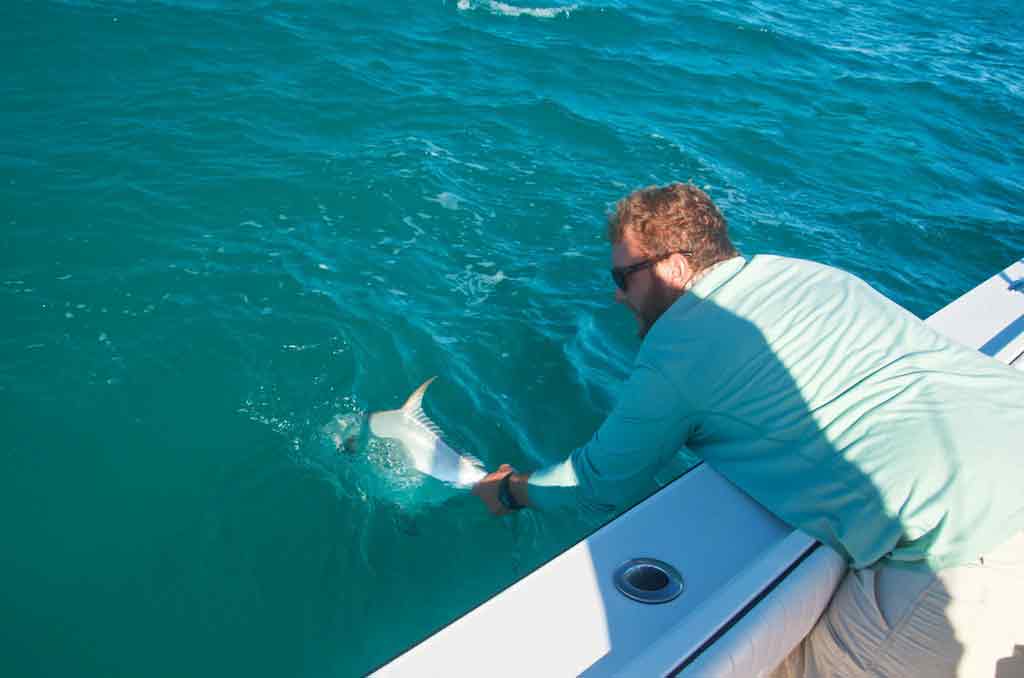 Permit are normally cruising the edges of channels and actually up on the flats in depths as shallow as 8 inches. Permit will stick their tail out of the water when they are feeding up on the flats, but this is not something that is always seen unless it’s slick calm out. Permit are usually spotted by their shapes of their bodies or the colors on their backs. They blend in so well to the grass flats in the backcountry, and it takes a professional eye to spot them most of the times. Once you do spot them doesn’t mean they are going to eat. Throwing a small, live crab at them or a shrimp is bettering your chance of a hook up, but permit have minds of their own and get scared by the smallest things. Sometimes when permit are traveling in schools up on the flats, one of the fish will actually scare one of the other ones if they are on edge. The hardest way to catch permit is using a fly rod, which is why tons of anglers come down to Key West year round to try their luck on fly. Permit are hard enough to catch on a spinning rod, but using a fly rod brings a whole new sport and difficulty factor. Many anglers have came down to the Keys for years and still have not had their chance to catch a permit. Many things sometimes have to add up for you to catch one: the weather, visibility, wind, tide, permits’ activity level, and of course – luck! Permit range from 5-40 pounds, and fight harder than most fish twice their size. Permit are not a fish that keep. They are a prized sport fish that even have their own tagging program.
Permit are normally cruising the edges of channels and actually up on the flats in depths as shallow as 8 inches. Permit will stick their tail out of the water when they are feeding up on the flats, but this is not something that is always seen unless it’s slick calm out. Permit are usually spotted by their shapes of their bodies or the colors on their backs. They blend in so well to the grass flats in the backcountry, and it takes a professional eye to spot them most of the times. Once you do spot them doesn’t mean they are going to eat. Throwing a small, live crab at them or a shrimp is bettering your chance of a hook up, but permit have minds of their own and get scared by the smallest things. Sometimes when permit are traveling in schools up on the flats, one of the fish will actually scare one of the other ones if they are on edge. The hardest way to catch permit is using a fly rod, which is why tons of anglers come down to Key West year round to try their luck on fly. Permit are hard enough to catch on a spinning rod, but using a fly rod brings a whole new sport and difficulty factor. Many anglers have came down to the Keys for years and still have not had their chance to catch a permit. Many things sometimes have to add up for you to catch one: the weather, visibility, wind, tide, permits’ activity level, and of course – luck! Permit range from 5-40 pounds, and fight harder than most fish twice their size. Permit are not a fish that keep. They are a prized sport fish that even have their own tagging program.
Pompano
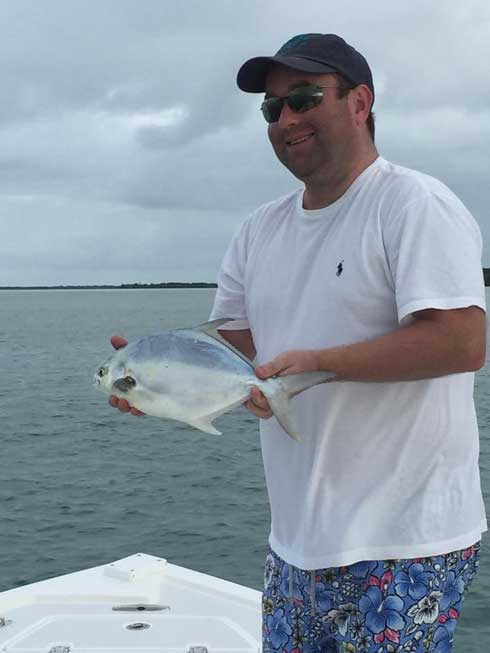 Pompano are more of a winter time species that we get into in the backcountry waters near Key West. Pompano live in shallow grassy areas, usually mixed in with ladyfish and jack crevalle. Pompano are in the jack family, and closely related to the permit. Pompano look a little bit like permit actually, with their dorsal and pectoral fins almost looking exactly like a permit. Pompano don’t get nearly as big though, and are usually just a couple pounds. Pompano are a good eating fish that we love to catch in the winter or cooler months in the backcountry. They have a very nice, white meat and can be grilled with the skin on them. Pompano have to be 11″ to the fork in their tails, and anglers can harvest 6 per day.
Pompano are more of a winter time species that we get into in the backcountry waters near Key West. Pompano live in shallow grassy areas, usually mixed in with ladyfish and jack crevalle. Pompano are in the jack family, and closely related to the permit. Pompano look a little bit like permit actually, with their dorsal and pectoral fins almost looking exactly like a permit. Pompano don’t get nearly as big though, and are usually just a couple pounds. Pompano are a good eating fish that we love to catch in the winter or cooler months in the backcountry. They have a very nice, white meat and can be grilled with the skin on them. Pompano have to be 11″ to the fork in their tails, and anglers can harvest 6 per day.
Jack Crevalle
 Jack crevalle, which we usually just call jacks, are one of the most powerful Key West fish species. They are a very strong fight, being one of the most powerful fish pound for pound. These jacks live in just about any environment, but are most common in our backcountry waters. Jacks like to be in channels, edges of flats, in between reefs, on top of wrecks, and even followers of bigger species like sharks and rays. Jack crevalle are one of the most common jacks that we catch. They eat just about anything you throw in front of them, and are super aggressive when they take your bait. They don’t really have much of an eating quality to them, so we either throw them back or use them for bigger game like sharks and goliath groupers. The average size jacks we get into are usually under 7 pounds, but we can see them throughout the year getting up to 20 pounds. Jack crevalle are a favorite among many anglers who come to Key West. They always put up a good fight.
Jack crevalle, which we usually just call jacks, are one of the most powerful Key West fish species. They are a very strong fight, being one of the most powerful fish pound for pound. These jacks live in just about any environment, but are most common in our backcountry waters. Jacks like to be in channels, edges of flats, in between reefs, on top of wrecks, and even followers of bigger species like sharks and rays. Jack crevalle are one of the most common jacks that we catch. They eat just about anything you throw in front of them, and are super aggressive when they take your bait. They don’t really have much of an eating quality to them, so we either throw them back or use them for bigger game like sharks and goliath groupers. The average size jacks we get into are usually under 7 pounds, but we can see them throughout the year getting up to 20 pounds. Jack crevalle are a favorite among many anglers who come to Key West. They always put up a good fight.
Yellow Jack

Yellow jack caught with some mangrove snappers.
Yellow jacks are similar to jack crevalle, as they are cousins to them. They are a little more slender in shape, and their heads are not as boxy. Yellow jacks live not only in shallow backcountry channels, but also in reef environments. Yellow jacks are a tasty fish as well, unlike the jack crevalle. They don’t have many teeth like crevalle jacks, but have rubbery lips more like permit. They will though eat a live bait, as where a permit will not. They are a cool species of fish, and aggressively get on your line like other jacks. Yellow jacks often come to the surface out of nowhere, since they mainly patrol shallow channels near the bottom. When one yellow jack comes to the surface, a bunch more follow, creating a yellow/golden appearance of fish at the surface. Yellow jacks are great because they have no bag or size limit, yet are still a very delightful fish to have at the dinner table. The average size of these fish are around 5-7 pounds, but not uncommon to see over 10.
Bonefish
 Bonefish are one of the most illusive flats species, even more hard to get into than a permit. Bonefish usually travel in pods of 2-6 fish, and are very hard to see on the flats. Bonefish are primarily caught by sight casting to them up on the flats, in less than 2 feet of water. Bonefish are one of the hardest fish to find out of the “big three” (bonefish, tarpon, permit). They are actually pretty easy to hook into once you can find them though, as they are very aggressive. Bone fishing can be done in a couple of different methods. The most publicized method would be to catch them using a fly rod. This is a more intermediate technique, if you are a fly fisherman. A lot of anglers think that is the only way to catch them but if you think about it, it makes no sense. Bonefish eat small crabs, shrimp, and other crustaceans on on the flats. Why would they only eat a fly that resembles a shrimp? Try using a REAL shrimp! They go nuts over even a piece of shrimp attached to a buck tail jig! Using a buck tail jig with a shrimp, or a weighted hook with a piece of shrimp on it is deadly for hooking into bones. All you have to do is get it near them, without spooking them, and usually they’ll eat it. Finding them is another story though. Bone fishing in Key West in the past few years has been a little more tough than it used to be. They seem to move around so much, and it is hard to find consistent numbers of them. They are already a hard fish to find, so when they move around so much due to fishing pressure they become super tough to get into. Bonefish also live just off the flats in deeper grass channels up to 20 feet. We have caught them bouncing buck tail jigs off the bottom when fishing for other species. Many anglers think bonefish are big for some reason, when the average size of them is actually 2-3 pounds. A big bonefish in Key West would be 7 pounds. Bonefish are a catch and release only species as well.
Bonefish are one of the most illusive flats species, even more hard to get into than a permit. Bonefish usually travel in pods of 2-6 fish, and are very hard to see on the flats. Bonefish are primarily caught by sight casting to them up on the flats, in less than 2 feet of water. Bonefish are one of the hardest fish to find out of the “big three” (bonefish, tarpon, permit). They are actually pretty easy to hook into once you can find them though, as they are very aggressive. Bone fishing can be done in a couple of different methods. The most publicized method would be to catch them using a fly rod. This is a more intermediate technique, if you are a fly fisherman. A lot of anglers think that is the only way to catch them but if you think about it, it makes no sense. Bonefish eat small crabs, shrimp, and other crustaceans on on the flats. Why would they only eat a fly that resembles a shrimp? Try using a REAL shrimp! They go nuts over even a piece of shrimp attached to a buck tail jig! Using a buck tail jig with a shrimp, or a weighted hook with a piece of shrimp on it is deadly for hooking into bones. All you have to do is get it near them, without spooking them, and usually they’ll eat it. Finding them is another story though. Bone fishing in Key West in the past few years has been a little more tough than it used to be. They seem to move around so much, and it is hard to find consistent numbers of them. They are already a hard fish to find, so when they move around so much due to fishing pressure they become super tough to get into. Bonefish also live just off the flats in deeper grass channels up to 20 feet. We have caught them bouncing buck tail jigs off the bottom when fishing for other species. Many anglers think bonefish are big for some reason, when the average size of them is actually 2-3 pounds. A big bonefish in Key West would be 7 pounds. Bonefish are a catch and release only species as well.
Barracuda
 The barracuda is the most underestimated fish on the water. They are mean, powerful, and fun to catch. Barracuda fishing can be done in almost any environment in Key West. Cudas live on the flats, in many scenarios in the backcountry, and definitely out on the reefs and wrecks. Barracuda can get up to 30 pounds in Key West, but typically average from 5-15 pounds. Barracudas can be picky at times, but usually go after anything fast moving and shiny. A lot of times, barracuda will hover under the boat and wait for fish that you are reeling in. They will then try and bite that fish in half or take it from you hook. This can be good if you’re trying to catch one, but bad if you were planning on eating that fish. Barracudas feed on almost everything smaller than them that swims. Barracudas can be caught using artificial plugs on the flats or near reefs and wrecks, live baiting, or trolling near the reefs. Barracudas have nasty teeth so it is best to tie on a piece of wire leader to the hook or lure you are using so that they cannot bite through it. Barracudas can go from being completely still to 40mph in a split second. This can really scare you if they are hovering under the boat awaiting your catch. Barracudas are said to be good eating in Mexico or some islands in the Caribbean. The reason we don’t eat them is because 1. their meat stinks really bad, and 2. the great barracuda can an cary a food borne illness called ciguatera. This poisoning has no true effective treatment, so it’s better to just not take the risk in eating a barracuda. There are many other tasty fish, like snapper, that we can get into that are way more safe to eat!
The barracuda is the most underestimated fish on the water. They are mean, powerful, and fun to catch. Barracuda fishing can be done in almost any environment in Key West. Cudas live on the flats, in many scenarios in the backcountry, and definitely out on the reefs and wrecks. Barracuda can get up to 30 pounds in Key West, but typically average from 5-15 pounds. Barracudas can be picky at times, but usually go after anything fast moving and shiny. A lot of times, barracuda will hover under the boat and wait for fish that you are reeling in. They will then try and bite that fish in half or take it from you hook. This can be good if you’re trying to catch one, but bad if you were planning on eating that fish. Barracudas feed on almost everything smaller than them that swims. Barracudas can be caught using artificial plugs on the flats or near reefs and wrecks, live baiting, or trolling near the reefs. Barracudas have nasty teeth so it is best to tie on a piece of wire leader to the hook or lure you are using so that they cannot bite through it. Barracudas can go from being completely still to 40mph in a split second. This can really scare you if they are hovering under the boat awaiting your catch. Barracudas are said to be good eating in Mexico or some islands in the Caribbean. The reason we don’t eat them is because 1. their meat stinks really bad, and 2. the great barracuda can an cary a food borne illness called ciguatera. This poisoning has no true effective treatment, so it’s better to just not take the risk in eating a barracuda. There are many other tasty fish, like snapper, that we can get into that are way more safe to eat!
Cobia
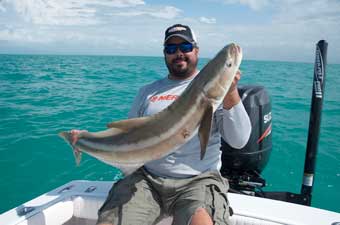 Cobia are one of our favorite fish to catch. We don’t see them year round though, as many of them are here only in the winter months when the water temperatures are cooler. Cobia are a prehistoric looking fish that looks like a combination of a sturgeon, a catfish, and a shark. Cobia usually come up to the surface when they are looking for food, and are known to hover on the bottom as well, near structure. They are found in the backcountry and flats environments following sharks and rays, while living in channels with good tidal movement. Usually right after a series of cold fronts is when we start to see some cobia showing up. The offshore and reef captains will usually be the first ones to spot these fish, as they take longer to make their appearance inshore. Cobia like to live near wrecks and reefs as well, and coming up in guys’ chum slicks behind their boat. Cobia are usually in packs of 2-5 fish, but sometimes by themselves. Cobia will eat a lot of different things, including fish you are reeling in, similar to barracudas. They are not the smartest fish, but one of the best eating and give a very powerful fight. Cobia are usually caught using live bait, and sight casting to them. You can also use plugs and lures, but throwing a live bait like a pin fish is more of a guaranteed opportunity to hook one. Cobia can get up to 70 pounds down in Key West, but the average size we see is about 20-35 pounds. Cobia have to be 33 inches to the fork in their tail to keep them, which is about a 12 pound fish. They have a very tough skin and are a little difficult to clean. Anglers can keep 1 cobia a day per person, and the boat max is 6.
Cobia are one of our favorite fish to catch. We don’t see them year round though, as many of them are here only in the winter months when the water temperatures are cooler. Cobia are a prehistoric looking fish that looks like a combination of a sturgeon, a catfish, and a shark. Cobia usually come up to the surface when they are looking for food, and are known to hover on the bottom as well, near structure. They are found in the backcountry and flats environments following sharks and rays, while living in channels with good tidal movement. Usually right after a series of cold fronts is when we start to see some cobia showing up. The offshore and reef captains will usually be the first ones to spot these fish, as they take longer to make their appearance inshore. Cobia like to live near wrecks and reefs as well, and coming up in guys’ chum slicks behind their boat. Cobia are usually in packs of 2-5 fish, but sometimes by themselves. Cobia will eat a lot of different things, including fish you are reeling in, similar to barracudas. They are not the smartest fish, but one of the best eating and give a very powerful fight. Cobia are usually caught using live bait, and sight casting to them. You can also use plugs and lures, but throwing a live bait like a pin fish is more of a guaranteed opportunity to hook one. Cobia can get up to 70 pounds down in Key West, but the average size we see is about 20-35 pounds. Cobia have to be 33 inches to the fork in their tail to keep them, which is about a 12 pound fish. They have a very tough skin and are a little difficult to clean. Anglers can keep 1 cobia a day per person, and the boat max is 6.
Ladyfish
 Ladyfish are a fun little fish that we get into in the backcountry. They are sometimes a day saver when the fishing is slow because they always give a good fight. Ladyfish are typically found mixed in with schools of jacks, pompano, sea trout, and blue runners. They are very similar to a tarpon in their shape and fight, but on a much smaller level. Some people call them a “poor man’s tarpon,” but aren’t actually directly related to a tarpon. They are in a whole different scientific family of fish, but yes, they do look a little similar. Their mouths are really course with no teeth, and have thin cartilage in between which lets them break free from the hook when they jump out of the water. Ladyfish have no eating quality, as the meat is mushy and there are pin bones all throughout. They are strictly a fun fish to catch, and have no bag limit…so they can also make a great shark or goliath grouper bait. Ladyfish like to dispose of waste on the boat which stains really bad on anything it hits, so we usually try to keep these fish boat side.
Ladyfish are a fun little fish that we get into in the backcountry. They are sometimes a day saver when the fishing is slow because they always give a good fight. Ladyfish are typically found mixed in with schools of jacks, pompano, sea trout, and blue runners. They are very similar to a tarpon in their shape and fight, but on a much smaller level. Some people call them a “poor man’s tarpon,” but aren’t actually directly related to a tarpon. They are in a whole different scientific family of fish, but yes, they do look a little similar. Their mouths are really course with no teeth, and have thin cartilage in between which lets them break free from the hook when they jump out of the water. Ladyfish have no eating quality, as the meat is mushy and there are pin bones all throughout. They are strictly a fun fish to catch, and have no bag limit…so they can also make a great shark or goliath grouper bait. Ladyfish like to dispose of waste on the boat which stains really bad on anything it hits, so we usually try to keep these fish boat side.
Spotted Sea Trout
 Trout are a fish that we get into primarily in the winter time. It takes a lot of cooler weather for trout to come into the Lower Keys and Key West. Sea trout live primarily to the North-East of Key West, and thrive in shallow basins where tide flows bait fish in from the Gulf of Mexico. Sea trout are caught all up the coast of Florida year round, but in Key West is just a winter thing. Each year is different, as far as the activity of these trout. Some years there are more than others. Trout are very good eating as well. Trout have to be 15-20 inches long to keep. Anglers can harvest up to 4 trout per person, and even keep one over 20 inches. Trout give a pretty decent fight, and sometimes come to the surface and shake their heads and jump. Trout are caught by using live shrimp on corks, artificial plugs, buck tail jigs, and soft artificial scented baits. All of these types of baits are presented while drifting the shallow basins where the trout are lurking in between the sea grass near the bottom.
Trout are a fish that we get into primarily in the winter time. It takes a lot of cooler weather for trout to come into the Lower Keys and Key West. Sea trout live primarily to the North-East of Key West, and thrive in shallow basins where tide flows bait fish in from the Gulf of Mexico. Sea trout are caught all up the coast of Florida year round, but in Key West is just a winter thing. Each year is different, as far as the activity of these trout. Some years there are more than others. Trout are very good eating as well. Trout have to be 15-20 inches long to keep. Anglers can harvest up to 4 trout per person, and even keep one over 20 inches. Trout give a pretty decent fight, and sometimes come to the surface and shake their heads and jump. Trout are caught by using live shrimp on corks, artificial plugs, buck tail jigs, and soft artificial scented baits. All of these types of baits are presented while drifting the shallow basins where the trout are lurking in between the sea grass near the bottom.
Lookdown
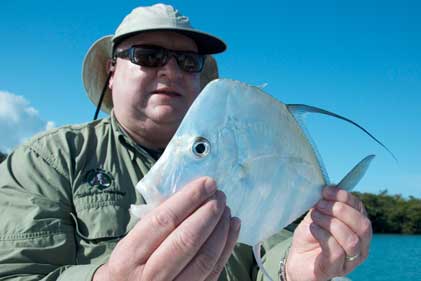 A lookdown is in the jack family, and is a very tropical, fish tank looking fish. They are really cool to catch because people enjoy viewing their weird shaped bodies. Look downs usually hang out in shallow backcountry environments. They like to hover on the bottom in channels, deeper grass flats, and edges. They are usually mixed in with a variety of snappers, other types of jacks, and ladyfish. They are definitely one fish that we see down here that are uncommon to catch elsewhere in the state.
A lookdown is in the jack family, and is a very tropical, fish tank looking fish. They are really cool to catch because people enjoy viewing their weird shaped bodies. Look downs usually hang out in shallow backcountry environments. They like to hover on the bottom in channels, deeper grass flats, and edges. They are usually mixed in with a variety of snappers, other types of jacks, and ladyfish. They are definitely one fish that we see down here that are uncommon to catch elsewhere in the state.
Mackerel
Spanish and Cero Mackerel

Spanish Mackerel
Spanish and cero mackerel are fish that we catch in the backcountry as well as the patch reefs in depths up to 120 feet. These mackerel are usually fine with eating plugs and artificial lures. They are sometimes caught while fishing the reef for snappers or groupers, as they will come by and swipe your bait mid level. Sometimes these mackerel can break you off if you aren’t using wire leader, since their teeth are razor sharp. The difference between Spanish mackerel and cero mackerel is that the Spanish have dots on them while the cero have lines going horizontally down their sides. The cero mackerel also get a little bigger. Cero mackerel have no size or bag limit, while Spanish mackerel have to be 12 inches to the fork in their tail. Anglers can keep up to 15 Spanish mackerel per person per day. The average size mackerel we get into are around 3-4 pounds, but can get up to 10.
King Mackerel (Kingfish)
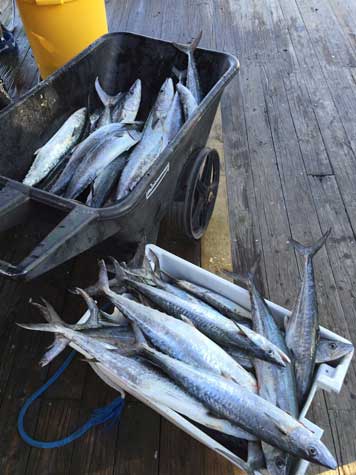 Kingfish are a deeper water mackerel that patrol the reefs and deep wrecks. They are one of the bigger species of mackerel (hence their name) next to the wahoo. Kingfish are caught by many different methods. Trolling, throwing plugs into a school, jigging, and live baiting are all good methods for catching king fish. King fish have to be 24 inches to the fork in their tail to keep them, and you can keep 2 per person per day. Kingfish are usually not caught in the backcountry, but sometimes are hooked when the water is churned up from a big storm or cold front (they sometimes get lost). Kingfish are more likely to be caught in the winter months near the reef. A lot of the offshore captains do real well on them with the cooler temperatures. Kingfish average around 15-30 pounds, but are not uncommon to see in the upper 50s.
Kingfish are a deeper water mackerel that patrol the reefs and deep wrecks. They are one of the bigger species of mackerel (hence their name) next to the wahoo. Kingfish are caught by many different methods. Trolling, throwing plugs into a school, jigging, and live baiting are all good methods for catching king fish. King fish have to be 24 inches to the fork in their tail to keep them, and you can keep 2 per person per day. Kingfish are usually not caught in the backcountry, but sometimes are hooked when the water is churned up from a big storm or cold front (they sometimes get lost). Kingfish are more likely to be caught in the winter months near the reef. A lot of the offshore captains do real well on them with the cooler temperatures. Kingfish average around 15-30 pounds, but are not uncommon to see in the upper 50s.
Sailfish, Tuna, Mahi-Mahi
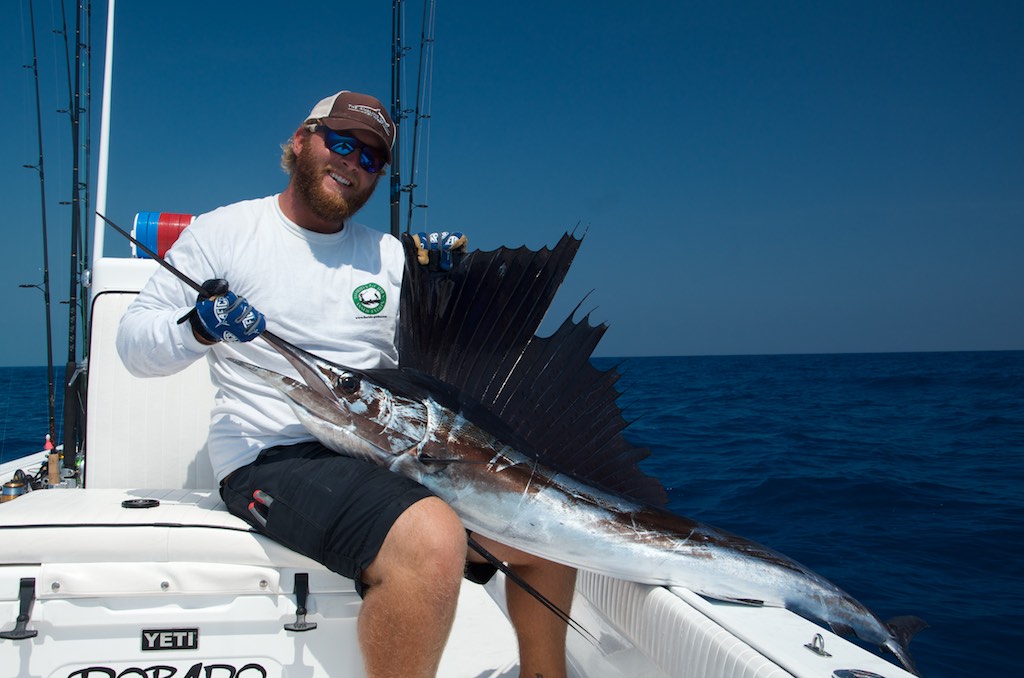 Sailfish, tuna, and dolphin (mahi-mahi) are among some of the pelagic species that we get into when we are fishing in the deep water past the reef. The days to get out there are limited by the boat, so most anglers who are interested in fishing for pelagic species go on an offshore style boat. There are times, where bay boats can get out past the reef. Catching a load of ballyhoo or pilchards can really make it happy out there. Live ballyhoo or even thread fins can be used for drifting the color changes past the reef. The pilchards are used primarily for chumming in the tunas and bonita. Tunas like to follow a trail of chum, and they’ll sometimes even eat off the back of the boat! Black fin tunas have no size or bag limit, which is awesome if you are a big fan of eating tuna or sushi! The mahi-mahi have a minimum size limit of 20 inches to the fork in their tail, and you can keep 10 per person with a 60 boat max (thats a lot of mahi). Sailfish and other billfish do have minimum size and bag limits (probably for world records and mounting) but it is very frowned upon to keep any type of billfish, as they are a high desired sport fish.
Sailfish, tuna, and dolphin (mahi-mahi) are among some of the pelagic species that we get into when we are fishing in the deep water past the reef. The days to get out there are limited by the boat, so most anglers who are interested in fishing for pelagic species go on an offshore style boat. There are times, where bay boats can get out past the reef. Catching a load of ballyhoo or pilchards can really make it happy out there. Live ballyhoo or even thread fins can be used for drifting the color changes past the reef. The pilchards are used primarily for chumming in the tunas and bonita. Tunas like to follow a trail of chum, and they’ll sometimes even eat off the back of the boat! Black fin tunas have no size or bag limit, which is awesome if you are a big fan of eating tuna or sushi! The mahi-mahi have a minimum size limit of 20 inches to the fork in their tail, and you can keep 10 per person with a 60 boat max (thats a lot of mahi). Sailfish and other billfish do have minimum size and bag limits (probably for world records and mounting) but it is very frowned upon to keep any type of billfish, as they are a high desired sport fish.
Other Key West Fish Species
There are a lot of other species that we catch in Key West that may not be the most popular or most sought after fish. Some fish we don’t get into every day, or many times throughout the year. These species include hogfish (hog snapper), cubera snapper, trigger fish, porgies, white grunts, margate snapper, school master snapper, lizard fish, triple tail, lion fish, blue fish, African pompano, amberjack, and wahoo. Species that are rare for Key West that are possible to catch but not likely (even less of a chance than redfish or snook) include sheepshead, black drum, flounder, and hardhead catfish.
Rare Key West Fish Species
Snook
 The snook is one of the most sought after fish in the flats and backcountry throughout the state of Florida. Snook like to live in subtropical coastal regions around the states, and can push into brackish and fresh water. They are a very smart fish, and are very easy to scare. Snook sometimes are caught out of Key West in the backcountry. They are more of a random fish to come across. A lot of captains know areas where snook can be found at some point in the year, but are never guaranteed to be there. We have caught some snook in the Marquesas Keys as well, also randomly. Snook like to live in structure, just like barracudas. In most areas where I’ve seen snook, we have seen barracudas. This is probably why snook don’t like to show themselves that much. There are definitely snook in areas around Key West like marinas and rock jetties, but catching them is another story. A note from Capt. Kyle Kelso: “In the years fishing the backcountry in Key West, I have only had my clients catch 7 snook total. That’s not a very good number of fish. This right here, shows how rare they are in Key West. I have seen them in the mangroves, near rock jetties hovering under barracudas, as well as on some shallow wrecks. Targeting them is something that I can not always effectively do! When I am able to get one of my anglers hooked up to a snook, it is a very rewarding moment.”
The snook is one of the most sought after fish in the flats and backcountry throughout the state of Florida. Snook like to live in subtropical coastal regions around the states, and can push into brackish and fresh water. They are a very smart fish, and are very easy to scare. Snook sometimes are caught out of Key West in the backcountry. They are more of a random fish to come across. A lot of captains know areas where snook can be found at some point in the year, but are never guaranteed to be there. We have caught some snook in the Marquesas Keys as well, also randomly. Snook like to live in structure, just like barracudas. In most areas where I’ve seen snook, we have seen barracudas. This is probably why snook don’t like to show themselves that much. There are definitely snook in areas around Key West like marinas and rock jetties, but catching them is another story. A note from Capt. Kyle Kelso: “In the years fishing the backcountry in Key West, I have only had my clients catch 7 snook total. That’s not a very good number of fish. This right here, shows how rare they are in Key West. I have seen them in the mangroves, near rock jetties hovering under barracudas, as well as on some shallow wrecks. Targeting them is something that I can not always effectively do! When I am able to get one of my anglers hooked up to a snook, it is a very rewarding moment.”
Redfish
 Many people who watch a lot of fishing TV shows think that the Keys are not only a big snook destination, but also a redfish destination (we don’t know why). Redfish are pretty sought after like snook, but easier to catch throughout the state. They are all over the Gulf Coast, and like being anywhere from the Everglades all the way to Texas. Redfish are not too common down in Key West, though we do catch them from time to time. We caught a lot of them after the BP Deepwater Horizon Oil spill, most likely because they had no where else to go that wasn’t toxic to them. Red fish like to live in mangrove channels, and are fairly easy to catch when they are present. Unless we get some crazy type of cold winter, they will not hang around too long. Catching them in the same spot more than one day in a row is very rare. They are here though on occasion, at least enough to talk about. *If you are interested in fishing for redfish or snook, you should look at going fishing out of Naples, FL, fishing in the Everglades, or in the South/Central coasts of Florida.
Many people who watch a lot of fishing TV shows think that the Keys are not only a big snook destination, but also a redfish destination (we don’t know why). Redfish are pretty sought after like snook, but easier to catch throughout the state. They are all over the Gulf Coast, and like being anywhere from the Everglades all the way to Texas. Redfish are not too common down in Key West, though we do catch them from time to time. We caught a lot of them after the BP Deepwater Horizon Oil spill, most likely because they had no where else to go that wasn’t toxic to them. Red fish like to live in mangrove channels, and are fairly easy to catch when they are present. Unless we get some crazy type of cold winter, they will not hang around too long. Catching them in the same spot more than one day in a row is very rare. They are here though on occasion, at least enough to talk about. *If you are interested in fishing for redfish or snook, you should look at going fishing out of Naples, FL, fishing in the Everglades, or in the South/Central coasts of Florida.
Backcountry Fish Species
- Sharks (Bull, Blacktip, Lemon, & Bonnet head)
- Snapper (Mangrove & Lane)
- Jacks (Crevelle & Yellow)
- Barracuda
- Permit
- Bonefish
- Tarpon
- Pompano
- Seatrout
- Cobia
Reef & Beyond Species
- Snapper (Yellowtail, Mangrove, & Mutton)
- Grouper (Red, Black, Gag, & Goliath)
- Dolphin (mahi-mahi)
- Blackfin Tuna
- Wahoo
- Kingfish
- Cobia
- Amberjack
- Permit
- Sailfish